Cover

Copyright

Published by Periplus Editions (HK) Ltd.
www.periplus.com Copyright 2003 Periplus Editions (HK) Ltd. All rights reserved. No part of this publication may be reproduced, stored in a retrieval system or transmitted in any form or by any means, electronic, mechanical, photocopying, recording or otherwise without the prior written permission of the publisher. ISBN: 9781462911158 (ebook) 15 14 13 12 11 8 7 6 5 4 3 2 Printed in Singapore 1107CP Photography: Masano Kawana Food Styling: Masano Kawana, Susie Donald Design: Periplus Design Team Distributors
Asia Pacific: Berkeley Books Pte Ltd, 61 Tai Seng Avenue, #0212 Singapore 534167 Tel (65) 6280 1330 Fax (65) 6280 6290.
Japan: Tuttle Publishing Yaekari Building, 3rd Floor 5412 Osaki, Shinagawa-ku Tokyo 1410032 Tel: (81) 3 54370171 Fax: (81) 3 54370755
Indonesia: PT Java Books Indonesia, JI.
Rawa Gelam IV No.9 Kawasan Industri Pulogadung Jakarta 13930, Indonesia Tel: 62 (21) 4682 1088 Fax: 62 (21) 461 0206. 
Basic Kitchen Utensils
 makisu
makisu hangiri
hangiri shamoji
shamoji hone nukiBamboo rolling mat
hone nukiBamboo rolling mat (
makisu): Widely available from Japanese supermarkets and very inexpensive, this simple bamboo mat is a must-have utensil if you want to roll rice inside wrappers of seaweed, and for rolling Japanese omelets.
Chopsticks (
saibashi): Look for the long wooden chopsticks used for cooking. Regular chopsticks are too short and may result in burns.
Fan (
uchiwa): A useful implement for cooling cooked sushi rice but if you can't find one, make your own.
Knife: Always use a very sharp knife and keep it out of reach of children.
Regular kitchen knives are fine but do remember to avoid using a serrated knife when cutting fish to avoid tearing the flesh. Wooden sushi rice bowl (hangiri): This low, wide wooden bowl is used to cool rice and give it the desired texture. The wider the bowl the better for you to separate the rice grains. Rice paddle (shamoji): This wooden scoop, which is used to spread cooked rice to cool in the hangiri, is perhaps the most symbolic kitchen utensil as it represents domestic authority. Whoever controls the shamoji in a Japanese household is surely in charge of the household affairs.
Ingredients
 Daikon
Daikon is a large, white radish often eaten raw-sliced or grated into long, thin strips-with sashimi and tempura.
Ingredients
 Daikon
Daikon is a large, white radish often eaten raw-sliced or grated into long, thin strips-with sashimi and tempura.
It is also pickled and sold in jars. Available in most supermarkets, it is regarded as a healthy antidote for oily foods. Dashi stock is the basic Japanese fish broth made from water, (see recipe page 10). It is also available in an instant version in powdered or granule form. This is useful when a small amount of stock is required for sauces and as a seasoning.  Deep-fried tofu slices ( (pages 26, 29).
Deep-fried tofu slices ( (pages 26, 29). Dried bonito flakes (katsuo bushi) are sold in plastic packs in the Japanese foods section of most supermarkets.
Dried bonito flakes (katsuo bushi) are sold in plastic packs in the Japanese foods section of most supermarkets.
The shavings come in varying sizes-larger flakes are used to make (page 10) whereas the finer ones are used as a garnish. Fish sauce is a fermented fish seasoning made by layering fish and salt in large jars and then siphoning off the liquid. It is sold bottled and is a common seasoning in Thai and Vietnamese food. Furikake is a dried seasoning mixture that is sprinkled over rice dishes and sushi. It consists of toasted seaweed, sesame seeds, ground dried fish and salt. Japanese cucumbers are smaller, thinner and sweeter than normal ones, and have much smaller seeds. Japanese cucumbers are smaller, thinner and sweeter than normal ones, and have much smaller seeds.
Substitute baby cucumbers or pickling gherkins if unavailable. Japanese mustard is similar to English mustard, but hotter-it is a blend of ground mustard seeds without any added flour. It can be purchased in powdered form in small cans or as a ready-to-use paste in tubes. Kanpyo are long, thin strips of dried gourd that are used in making sushi and slow-cooked dishes; also for tying food together. They are sold in plastic packets in the dried foods section of Japanese stores, and many supermarkets.  Konbu is a dried kelp in the form of flat, black sheets with white powder on the surface, used to flavor (page 10).
Konbu is a dried kelp in the form of flat, black sheets with white powder on the surface, used to flavor (page 10).
The kelp's flavor infuses quickly in water, so do not wash it before cooking-just wipe to remove any dust or powder. Konbu is often removed before a dish is served.  Lotus roots are tubers with a crunchy, starchy flavor in their raw form and a characteristic lacy pattern in cross-section. They are either sold covered in mud or cleaned and sealed in plastic packets. Mirin is a sweet cooking wine made by mixing steamed glutinous rice with distilled spirits and sugar. The resulting liquid contains 1214% alcohol.
Lotus roots are tubers with a crunchy, starchy flavor in their raw form and a characteristic lacy pattern in cross-section. They are either sold covered in mud or cleaned and sealed in plastic packets. Mirin is a sweet cooking wine made by mixing steamed glutinous rice with distilled spirits and sugar. The resulting liquid contains 1214% alcohol.
Avoid products labeled "ajimirin" as they are a MSG-flavored version. Miso is an important seasoning in Japan-a fermented paste made from soybeans and rice, wheat or barley. Available in various colors and flavors, but the most common are red and white misos, which are used in miso soups. Available in most supermarkets. Nori are the dried leaves of a seaweed called laver, and are generally sold in 20 x 17 cm (8 x 7-in) sheets and used for wrapping sushi or cut into squares for cone sushi. Nori is best toasted before serving to make it crisp and fragrant ( on page 42).
Also sold pretoasted and packed flat in bags. 


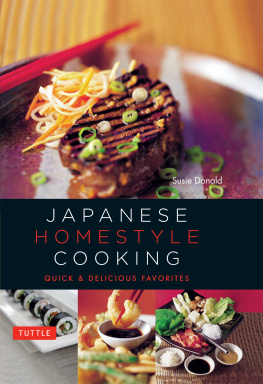
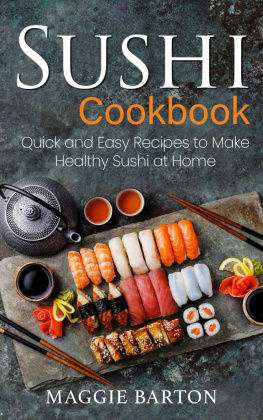
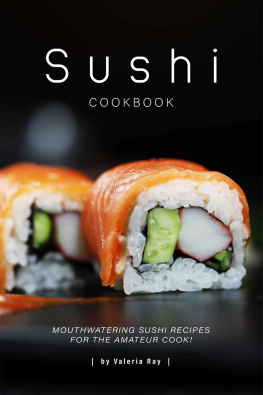
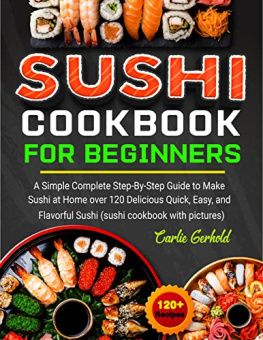




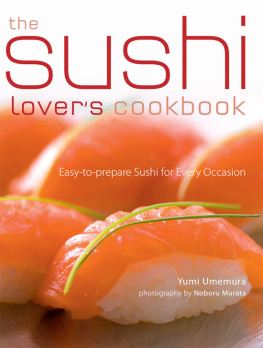
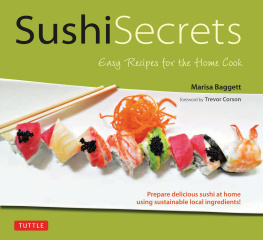

 Published by Periplus Editions (HK) Ltd. www.periplus.com Copyright 2003 Periplus Editions (HK) Ltd. All rights reserved. No part of this publication may be reproduced, stored in a retrieval system or transmitted in any form or by any means, electronic, mechanical, photocopying, recording or otherwise without the prior written permission of the publisher. ISBN: 9781462911158 (ebook) 15 14 13 12 11 8 7 6 5 4 3 2 Printed in Singapore 1107CP Photography: Masano Kawana Food Styling: Masano Kawana, Susie Donald Design: Periplus Design Team Distributors Asia Pacific: Berkeley Books Pte Ltd, 61 Tai Seng Avenue, #0212 Singapore 534167 Tel (65) 6280 1330 Fax (65) 6280 6290. Japan: Tuttle Publishing Yaekari Building, 3rd Floor 5412 Osaki, Shinagawa-ku Tokyo 1410032 Tel: (81) 3 54370171 Fax: (81) 3 54370755 Indonesia: PT Java Books Indonesia, JI.
Published by Periplus Editions (HK) Ltd. www.periplus.com Copyright 2003 Periplus Editions (HK) Ltd. All rights reserved. No part of this publication may be reproduced, stored in a retrieval system or transmitted in any form or by any means, electronic, mechanical, photocopying, recording or otherwise without the prior written permission of the publisher. ISBN: 9781462911158 (ebook) 15 14 13 12 11 8 7 6 5 4 3 2 Printed in Singapore 1107CP Photography: Masano Kawana Food Styling: Masano Kawana, Susie Donald Design: Periplus Design Team Distributors Asia Pacific: Berkeley Books Pte Ltd, 61 Tai Seng Avenue, #0212 Singapore 534167 Tel (65) 6280 1330 Fax (65) 6280 6290. Japan: Tuttle Publishing Yaekari Building, 3rd Floor 5412 Osaki, Shinagawa-ku Tokyo 1410032 Tel: (81) 3 54370171 Fax: (81) 3 54370755 Indonesia: PT Java Books Indonesia, JI. 
 makisu
makisu hangiri
hangiri shamoji
shamoji hone nukiBamboo rolling mat (makisu): Widely available from Japanese supermarkets and very inexpensive, this simple bamboo mat is a must-have utensil if you want to roll rice inside wrappers of seaweed, and for rolling Japanese omelets. Chopsticks (saibashi): Look for the long wooden chopsticks used for cooking. Regular chopsticks are too short and may result in burns. Fan (uchiwa): A useful implement for cooling cooked sushi rice but if you can't find one, make your own. Knife: Always use a very sharp knife and keep it out of reach of children.
hone nukiBamboo rolling mat (makisu): Widely available from Japanese supermarkets and very inexpensive, this simple bamboo mat is a must-have utensil if you want to roll rice inside wrappers of seaweed, and for rolling Japanese omelets. Chopsticks (saibashi): Look for the long wooden chopsticks used for cooking. Regular chopsticks are too short and may result in burns. Fan (uchiwa): A useful implement for cooling cooked sushi rice but if you can't find one, make your own. Knife: Always use a very sharp knife and keep it out of reach of children.  Daikon is a large, white radish often eaten raw-sliced or grated into long, thin strips-with sashimi and tempura.
Daikon is a large, white radish often eaten raw-sliced or grated into long, thin strips-with sashimi and tempura.  Deep-fried tofu slices ( (pages 26, 29).
Deep-fried tofu slices ( (pages 26, 29). Dried bonito flakes (katsuo bushi) are sold in plastic packs in the Japanese foods section of most supermarkets.
Dried bonito flakes (katsuo bushi) are sold in plastic packs in the Japanese foods section of most supermarkets. Konbu is a dried kelp in the form of flat, black sheets with white powder on the surface, used to flavor (page 10).
Konbu is a dried kelp in the form of flat, black sheets with white powder on the surface, used to flavor (page 10). Lotus roots are tubers with a crunchy, starchy flavor in their raw form and a characteristic lacy pattern in cross-section. They are either sold covered in mud or cleaned and sealed in plastic packets. Mirin is a sweet cooking wine made by mixing steamed glutinous rice with distilled spirits and sugar. The resulting liquid contains 1214% alcohol.
Lotus roots are tubers with a crunchy, starchy flavor in their raw form and a characteristic lacy pattern in cross-section. They are either sold covered in mud or cleaned and sealed in plastic packets. Mirin is a sweet cooking wine made by mixing steamed glutinous rice with distilled spirits and sugar. The resulting liquid contains 1214% alcohol.